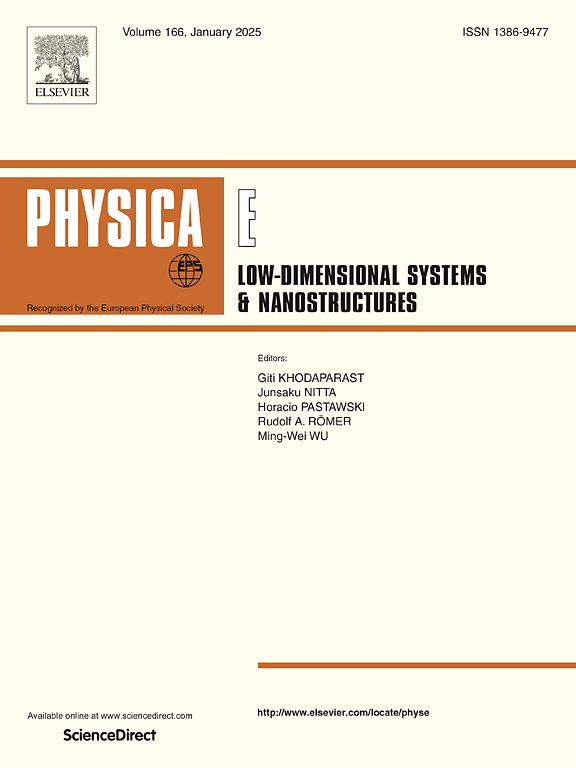Role of edge reconfiguration in generating corner states in Zigzag graphene nanoribbons
IF 2.9
3区 物理与天体物理
Q3 NANOSCIENCE & NANOTECHNOLOGY
Physica E-low-dimensional Systems & Nanostructures
Pub Date : 2025-04-18
DOI:10.1016/j.physe.2025.116260
引用次数: 0
Abstract
The study investigates the significance of edge architecture in graphene nanoribbons and its implications on electronic properties and transport behavior. Particularly, it explores the effects of edge reconstruction on Zigzag graphene nanoribbons, focusing on the impact of (5, 7) edge remodeling caused by Stone–Wales defects on topological features and edge states. The energy band structure and state distribution of the reconfigured Zigzag (5, 7) graphene nanoribbon were examined using the tight-binding model. The findings indicate that the edge reconstruction creates energy gaps in the edge-state bands, resulting in the appearance of corner states at the vertices of rectangular graphene nanoflakes with reconstructed edges. Furthermore, analysis of the boundary atomic structure unveiled an SSH4-like configuration at the edges, forming a topological structure that gives rise to zero-energy corner states and two distinct nonzero-energy corner states. The study also notes a transition of non-zero energy corner states towards zero energy influenced by bulk and edge states, while zero-energy corner states shift towards non-zero energy and some merge with the edge states. Nevertheless, the impact of the staggered potential largely restores the corner states determined by the edge structure. This research underscores the significant implications of Stone–Wales-deficient reconfiguration on the topological properties and edge states of Zigzag graphene nanoribbons, providing a theoretical basis for tailoring electron transport characteristics and guiding the development of advanced optoelectronic devices.
边缘重构在之字形石墨烯纳米带产生角态中的作用
本研究探讨了石墨烯纳米带边缘结构的意义及其对电子性质和输运行为的影响。特别地,它探讨了边缘重建对之字形石墨烯纳米带的影响,重点关注由Stone-Wales缺陷引起的(5,7)边缘重塑对拓扑特征和边缘状态的影响。利用紧密结合模型研究了重构后之字形(5,7)石墨烯纳米带的能带结构和态分布。研究结果表明,边缘重建在边缘状态带中产生能量间隙,导致边缘重建的矩形石墨烯纳米片的顶点出现角态。此外,对边界原子结构的分析揭示了边缘处类似ssh4的构型,形成了一个拓扑结构,产生了零能量角态和两个不同的非零能量角态。该研究还注意到非零能量角态在体态和边缘态的影响下向零能量过渡,而零能量角态向非零能量转移,有些与边缘态合并。然而,交错电位的影响在很大程度上恢复了由边缘结构决定的角态。本研究强调了stone - wales缺陷重构对之字形石墨烯纳米带拓扑性质和边缘状态的重要影响,为定制电子输运特性和指导先进光电器件的发展提供了理论依据。
本文章由计算机程序翻译,如有差异,请以英文原文为准。
求助全文
约1分钟内获得全文
求助全文
来源期刊
CiteScore
7.30
自引率
6.10%
发文量
356
审稿时长
65 days
期刊介绍:
Physica E: Low-dimensional systems and nanostructures contains papers and invited review articles on the fundamental and applied aspects of physics in low-dimensional electron systems, in semiconductor heterostructures, oxide interfaces, quantum wells and superlattices, quantum wires and dots, novel quantum states of matter such as topological insulators, and Weyl semimetals.
Both theoretical and experimental contributions are invited. Topics suitable for publication in this journal include spin related phenomena, optical and transport properties, many-body effects, integer and fractional quantum Hall effects, quantum spin Hall effect, single electron effects and devices, Majorana fermions, and other novel phenomena.
Keywords:
• topological insulators/superconductors, majorana fermions, Wyel semimetals;
• quantum and neuromorphic computing/quantum information physics and devices based on low dimensional systems;
• layered superconductivity, low dimensional systems with superconducting proximity effect;
• 2D materials such as transition metal dichalcogenides;
• oxide heterostructures including ZnO, SrTiO3 etc;
• carbon nanostructures (graphene, carbon nanotubes, diamond NV center, etc.)
• quantum wells and superlattices;
• quantum Hall effect, quantum spin Hall effect, quantum anomalous Hall effect;
• optical- and phonons-related phenomena;
• magnetic-semiconductor structures;
• charge/spin-, magnon-, skyrmion-, Cooper pair- and majorana fermion- transport and tunneling;
• ultra-fast nonlinear optical phenomena;
• novel devices and applications (such as high performance sensor, solar cell, etc);
• novel growth and fabrication techniques for nanostructures

 求助内容:
求助内容: 应助结果提醒方式:
应助结果提醒方式:


